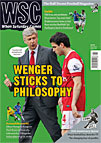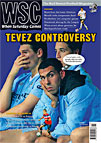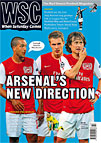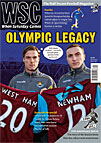 Dear WSC
Dear WSC
My thanks to Phil Robbins (Letters, WSC 290) for pointing out the usual mistakes made about the identity of the Milan clubs. Another thing that really annoys me is the common error over the name of their shared stadium. It is not the San Siro. It is the Giuseppe Meazza. San Siro is the district it’s in. In England one would say the Boleyn Ground but never the Upton Park. That would be daft, wouldn’t it?
Gary Valentini, Leeds
Dear WSC
In his letter in WSC 290, Phil Robbins raised a good point about English commentators getting the names of the Milan teams wrong. He then went on to say that both Internazionale and Milan play at the San Siro, which is something that until recently I didn’t realise is technically incorrect. Brian Glanville put me straight in his World Soccer column. Although almost universally referred to in Britain as the San Siro, the correct term is simply San Siro, which is the name of the district the stadium is situated in. So calling it the San Siro is a bit like saying Liverpool are playing at the Anfield. On the subject of commentator mistakes, I’m sure Arrigo Sacchi would have been a little cheesed off had he known that during the recent Spurs v Milan game, Clive Tyldesley referred to Milan as Fabio Capello’s team. Although Clive is correct in recognising that Fabio enjoyed success at Milan, it was built largely upon solid foundations laid by Sacchi, who brought Ruud Gullit, Frank Rijkaard and Marco van Basten to the club as well as winning back-to-back European Cups in 1989 and 1990. Small beans, of course, but still relatively important if you are peddling so-called expert views on television.
Emerson Marks, Southampton
Dear WSC
Continuing the theme of daft phrases used by commentators and pundits, I’d like to point out my own personal favourite. Towards the end of each season we’re repeatedly told that the teams in the promotion frame are desperate to avoid “the lottery of the play-offs”. Like every other football contest the play-offs involve skill, pace, strength, tactics, concentration, commitment, along with a healthy slice of luck, and more often than not the best team wins. Quite often that team may not have been the better side throughout the regular league season but that’s a different issue. It’s interesting that the same term is never applied to other knockout contests. Since the two competitions use exactly the same format then surely we should also be discussing “the lottery of the Champions League semi-finals”. Unsurprisingly, I’ve never heard either ITV or Sky use that particular phrase when promoting their live coverage. However, if the pundits are right then perhaps we should seek solace in the randomness of it all. The next time England make their customary quarter-final exit, rather than descending into despair, the nation could take comfort in avoiding the lottery of the World Cup semis.
Karl Laycock, Mansfield
Dear WSC
I suspect that the concentration of youth players inw Premier League academies is already in full swing, if my club Leyton Orient are anything to go by. Currently having our best season since the late 1970s, it’s a niggling fact that none of our current first team come from our youth system. At least five mainstays of the team (Jamie Jones, Ben Chorley, Terrell Forbes, Jimmy Smith, Charlie Daniels) are youth-team products from Premier League clubs who have had to drop down the divisions to find regular football. Three current first-team players (Tom Carroll, Harry Kane, Paul-Jose M’Poku) are on loan from Tottenham, and have played vital parts in our season so far. The fact is, we and other lower-league clubs rely on youth players from wealthier teams to reinforce our squads. The issue seems to me not so much that smaller clubs are not properly reimbursed for training young players, but that the big clubs already have a powerful grip on the developing talent in this country.
Phil Laing, Chingford
Dear WSC
I found your article on British voices covering American soccer telecasts dead on (Losing the legacy, WSC 289). As a fan of the New York Red Bulls and the US national team, I can assure you that I find Red Bulls announcer Shep Messing’s Bronx accent and detailed knowledge of every player in MLS infinitely more enjoyable than hearing Steve McManaman ramble on without any knowledge of the American game whatsoever. I wouldn’t mind his accent, of course, if the former star had bothered to learn anything at all about the teams he was covering. His lack of interest in doing so showed a remarkable lack of respect for MLS, a league which draws well, is entertaining and has fuelled the development of the national team. While I certainly appreciate the game’s English history, having someone thoroughly ignorant of American soccer broadcast matches in the US is aggravating. The US is finally developing its own style of play and own systems of player development, yet it seems more determined than ever to “Anglo-cast”. Maddening.
William J Smith, Brooklyn, USA
Dear WSC
The WSC 290 Season In Brief about the Australian National Soccer League prompted happy memories of watching the Wollongong Wolves at Marconi Fairfield one winter’s night in Sydney in – I would guess – June 1998. After a goalless first half the visiting wolf mascot was doing the rounds, as mascots do, a few rows in front of me. Without preamble a man punched the wolf in the head. Even more remarkably, someone pointed out the attacker to a steward, who gave the guilty man a talking-to. Through the power of WSC, can anyone tell me what became of any of them?
Mark Rowe, Burton upon Trent
Dear WSC
I wasn’t around to see the Australian National Soccer League’s birth in 1977. But your Season In Brief brought back fond memories of the seasons that followed. For many years the NSL was a much-loved competition. It was passionately followed by those who knew what true football was, in a country dominated by other codes. We witnessed the formative years of some greats (Mark Viduka, Robbie Slater, Danny Tiatto and Brett Emerton, to name just a few). Yet as the article correctly describes, there was an inevitability about the league’s demise nearly 30 years later. It descended into a farce. Inept administrators, dwindling crowds, barren sponsorship and clubs stuck in old-world ethnic rivalries. At its nadir Peter Beardsley came out of retirement and played two miserable games for the Melbourne Knights. Sadly for some of us, the A-League is yet to fill the void. Crowds trebled in some cities and the breadth of support for the competition has clearly spread. Yet much of the substance of the game has gone. Matches are screened only on pay TV and freshly minted club supporters complain about the “touch judge”. When the A-League was launched in 2005 it was to much hope and fanfare. Since then two clubs have folded, finances have fluctuated and the games expansion has been put on hold. Now it would seem we’re not the only ones a little lost.
Dashiel Lawrence, Melbourne, Australia
Dear WSC
Like Alan Bunce (Letters, WSC 290), I too am driven to despair by the FA Cup draw. However, for me, it has become a real-life example of the proverb: be careful what you wish for, it might come true. Jim Rosenthal has taken to a new level the trend to throw in an inane comment after he reads out the team’s name when their ball number is called. I wouldn’t mind if he said something controversial, such as: “Manchester United, for whom Wayne Rooney will be available to play after getting away with a blatant elbow in the face yesterday.” What we actually get is inanities like: “Manchester United… a late winner at home yesterday.” I point the finger of blame at David Davies OBE, former executive director of the FA. I still remember how he used to add a little extra to the draw, supposedly for the benefit of the less well informed. The nadir was surely this: “Portsmouth… Pompey… from the south coast.” I’m a Southampton fan and even I was insulted, and I remember wishing they would put a trained broadcaster in his place. Well, they did. Enough said.
Tim Manns, Plymouth
Dear WSC
I must correct Dave Lee (Flood risks, WSC 290), who suggested that the FA was responsible for charging fans to watch Ukraine v England online in 2009. The FA didn’t own the rights to that fixture, they belonged to the Ukrainian FA, who originally sold them to Setanta. When they went bust, their agents Perform opted for the online model in lieu of, they claimed, any serious bids from another broadcaster. The FA have absolutely no say as to what happens with the TV rights for away qualifiers, Setanta just bought that one off their own back.
However you’re right to say that the FA did opt for online streaming of Under-21 matches, as well as additional FA Cup games, that were originally part of their contract with Setanta. The difference between the FA’s streaming and the Ukraine v England affair is that, as mentioned, the FA offers them for free.
Steve Williams, Cleethorpes
Dear WSC
In football it is an old adage that “a good player doesn’t become a bad one overnight”. This is certainly true of Fernando Torres – it has taken him the best part of a year.
Geoff Laidlaw, Newcastle upon Tyne
Dear WSC
In his letter in WSC 290 regarding who was overlooked for inclusion in the “Disappearing from view” section of Season In Brief, Tim Curtis seems to have misunderstood the inclusion criteria. As I understand it, those named are not necessarily players, teams or managers that have ended up furthest away from where they played in the season in question (like his suggestions of Barry Hayles, Andy Melville and Matt Jansen) but rather someone or something that reached the end of a glorious or noteworthy career during or around that season. Colin Calderwood was about to retire so his inclusion is entirely justified, while Tom’s suggestions all had reasonably significant careers after the end of 2000-01. Barry Hayles played three further seasons for Fulham, all in the Premier League, representing the highest level he played at before or since. Andy Melville retired in 2005 having also played in the top flight for the same three seasons for Fulham before a short spell at West Ham. Matt Jansen was only 24 in 2002 and, while a motorcycle accident in 2002 seemed to stall his promising progress, he continued with Blackburn and Bolton in the top division for a further five years. As for Ossie Ardiles, I’m pretty certain he would qualify as having disappeared from view after his sacking from Spurs in October 1994 – the following 17 years have seen short, largely unsuccessful spells at ten different clubs across the world. But he wasn’t managing in Division One in 2001 so he doesn’t really qualify for consideration for this particular article.
Fred Sullivan, Manchester
Dear WSC
Paul Knott’s praise of Ian Ashbee in WSC 290 was well merited. However, Paul should in future be more careful with his use of the word unique. In describing Ashbee’s feat of captaining his club in all four divisions, Paul would have been better advised to have used another descriptive term because it is certainly not unique. Ladies, gentlemen and WSC readers, I give you Don Masson. He not only captained Notts County in all four divisions but must surely be unique in as much as he also captained his country.
Mike Gyles, Alfreton
Dear WSC
In response to Keith Chapman’s letter in WSC 290, I can put his mind at rest. As a lifelong Newcastle fan (of the armchair variety in recent years) it pains me to say that I have reliable eyewitness accounts from St James’ Park of fans leaving the ground with the score at 4-0 to Arsenal, somehow unable to foresee the Gunners’ spectacular second-half capitulation. According to my source they numbered in the hundreds (probably about 30 or so accounting for excited exaggeration) and one hapless individual even volunteered to be interviewed by the local media in the days after the game declaring his misfortune at missing a stirling comeback by the Magpies. I can’t confirm that the individuals shown on MOTD were among those that actually left the ground, but I can with some confidence assure Mr Chapman that the BBC certainly didn’t “make it up about people leaving at half time”. Not this time anyway.
Paul Morrow, Newcastle upon Tyne
Dear WSC
While I wouldn’t want to defend the logic of splitting the SPL into two leagues after 33 games, there is certainly a logic and fairness behind preventing the seventh-placed team leapfrogging the sixth-placed team – in fact, unless there was a huge gap between the two after 33 games, you would expect it to happen. The sixth-placed team has to play against the five teams that finished above them, which is clearly a harder task than playing against the bottom five, as the seventh-placed team is required to do. I’d suggest that the SPL consider splitting the league between the top two and the bottom ten at the halfway stage, so that we can all enjoy the spectacle of Messrs McCoist and Lennon being banished to the stands on a weekly basis, but I fear they might take this idea seriously.
John Rooney, Bristol
From WSC 291 May 2011
 When clubs get it wrong off the pitch, it can be the manager who unfairly pays the price
When clubs get it wrong off the pitch, it can be the manager who unfairly pays the price

